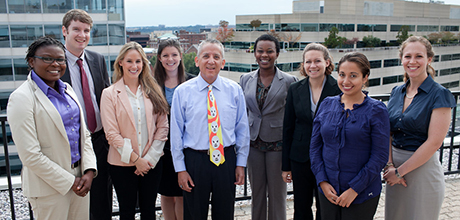The Executive Office for Immigration Review in Arlington, Va., known as immigration court, can make anyone nervous. People duck in and out of eight cramped courtrooms for proceedings that end as quickly as they begin. Suited lawyers shuffle papers from their briefcases for last-minute reviews. Family members sit on brown benches, bouncing their legs up and down in anticipation. But as law student Rebekah Niblock prepared to go before Judge Lawrence Burman on May 8, she knew she had to remain calm.
Ms. Niblock is one of eight law students who worked at the George Washington University’s Immigration Law Clinic this year. She represented a Central African man seeking asylum at a hearing known as a “master calendar”—her first time in front of a judge. Although her client won asylum in 2010, his victory was overturned by the Board of Immigration Appeals. It was up to Ms. Niblock to get his asylee status reinstated.
The hearing is no simulation, said Alberto Benítez, professor of clinical law and director of the Immigration Law Clinic.
“This is not an exercise where you can say, ‘Well, we lost but it was a nice try.’ If we lose, people are in danger of losing their lives if they return to their home countries,” he said.
The GW Immigration Law Clinic has given law students the opportunity to represent undocumented noncitizens in D.C. since 1979. Currently housed on Pennsylvania Avenue, it is one of the Jacob Burns Community Legal Clinics, established by former trustee Jacob Burns, L.L.B. ’24.
Mr. Benítez became director in 1996 with a goal of shaping students into seasoned lawyers through firsthand work experience. He pores through a flood of applications each year before selecting eight students to take under his wing. The clinic is free of charge and extremely popular, so students must keep up with a frenetic pace. They’re currently working on 31 cases with clients from nearly 14 different countries.
Luckily, this year’s students proved themselves masterful legal practitioners, winning asylum for six clients—without losing a single case. Part of their success lies with their fast-talking, energetic director. The team praises Mr. Benítez for his tireless spirit and detail-oriented nature. But he admitted he pushes students, often wearing a T-shirt that boldly declares the clinic’s mantra: “Victory is the only option.”
Law student Emma Brown said although challenging, she knows Mr. Benítez “critiques me for my own good. When he’s pushing me, it’s because he wants me to be the best lawyer I can be.”
Mr. Benítez is also known for a hands-off approach. He lets students handle nearly all aspects of cases, including initial interviews with potential clients. Ms. Niblock, Ms. Brown and their colleagues have heard stories about everything from people terrified of torture to parents desperate to stay in the country with their American-born babies. They handle research, put together trial packets and represent clients before judges, asylum officers and Citizenship and Immigration Services adjudicators.
Two types of cases prevail at the clinic: Removal proceedings, in which the clinic defends clients against removal requests from Immigration and Customs Enforcement (ICE), and affirmative asylum, in which clients request asylum. After interviews, Mr. Benítez and the students confer about whether or not the clinic is the most appropriate option for the client. If Mr. Benítez believes the content would make a good learning experience, the clinic takes the case.
No story or client ever fades, said Ms. Brown. She still thinks about an African man she represented earlier this year who faced persecution in his home country because of his sexual orientation. The man was granted asylum after Ms. Brown spent months on his case.
“I think I was more worried than he was. If we did not win the asylum and he returned to his country, he could be killed just because of who he is,” Ms. Brown said. “I kept thinking, ‘I cannot afford to lose this case.’ I had to do everything possible to ensure his safety.”
One reality students must quickly accept is the complicated red tape surrounding immigration law. Applications for asylum are returned for miniscule reasons, like missing signatures or misspellings, restarting weeks of work. It can take months—even years—to schedule hearings, and a client might wait one to three years for legal proceedings to begin. The arduous processes are, more often than not, exasperating.
Ms. Niblock’s May 8 master calendar hearing was no exception. Because a different judge adjudicated her client’s original asylum claim, the clinic must present the case all over again to Judge Burman in January 2014—drawing the process out an additional eight months. Ms. Niblock will have graduated by then, but knowing the determination of the clinic and Mr. Benítez, she isn’t discouraged.
“This is a good thing. When the clinic represents him in 2014, we will win,” she declared.
And the clinic will keep fighting, Mr. Benítez said, because although the stakes are high, nothing measures up to the rewards reaped after winning a case.
“A few years ago, we won relief for an El Salvadoran man whose kids were U.S. born. His little son tugged on the student lawyer’s leg and said, ‘Thanks for saving my daddy,’ ” Mr. Benítez recalled. “There’s nothing quite like that type of thank you.”


